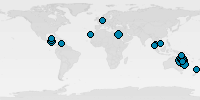
The 126 meter long Kyarra is a great wreck dive with sightings of ribs, boilers and plenty of places to enter the cargo-passenger liner.
| Name Dive Site: | Kyarra |
| Depth: | 59-111ft (18-34m) |
| Inserted/Added by: | diversdownswanage |
| Rated: | Rated not yet |
| Specifications: |   |
| GPS: | N50°34.90', W1°56.57' |
Send us your images for this dive site[Add Image][Add Movie]
The Kyarra is a 4383 ton, twin-screw passenger and cargo liner, 415ft long with a beam of 52ft, launched in 1903. She lies 1.5 miles from Swanage Pier, at a depth of 30m, rising to 18m in some places. She is also known as "the ship that was made of brass" owing to the large numbers of brass fittings used in her construction. From stem to stern, her portholes were heavy brass and her interior and exterior fittings solid brass, as were door handles, navigation lamps, nameplates and even the end-supports of the benches on her decks.
The Kyarra plied the England-to-Australia run for the Australasian United Steam Navigation Co. She was requisitioned in World War One for use as a hospital ship, bringing home casualties from the battlefields in Flanders, today part of Belgium. After the war, she returned to her previous trading route and was bound for Sydney from Southampton when she was torpedoed by a German submarine on 5 May, 1918. She was hit amidships, killing six crew and sank very quickly, most of the crew were able to escape using the lifeboats. Ron Blake and his wife Linden were the next to see her when they dived an obstruction they thought was a reef in 1966. They discovered just how mixed her cargo was - bottles of champagne, red wine, beer and vinegar, bales of silk and cloth, French perfume, lino, sealing wax, medical supplies, cigarettes, silver purses, men's pocket watches, ladies gold wrist-watches and, of course, masses of brass.
Most scuba divers start their dive amidships on the port railing because that is where a buoy is invariably tied on to the wreck. It is a great opportunity to use nitrox which makes it possible to see the complete wreck in one dive. Highlights on the wreck are a boiler poking out through the open wreck, a collapsed mast and plenty of boat derricks. You may find little puddles of silver on the seabed; liquid mercury spilled from the cargo. With this dive site being quite busy, skippers generally prefer divers to release a delayed SMB rather than crowd the line and possibly pull the buoy under. Again, it is one of the best and most popular wreck dives in all of the UK, a must while scuba diving in Dorset.
[Add Message]Messages from readers:
[Add Divelog]Divelogs from members:
